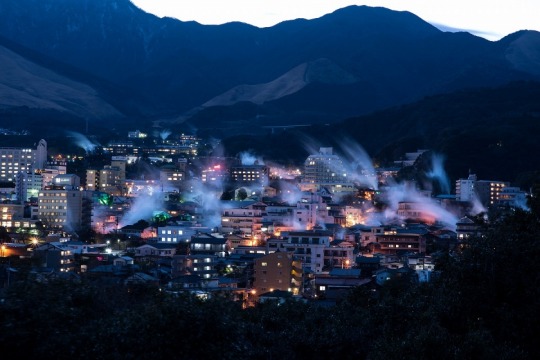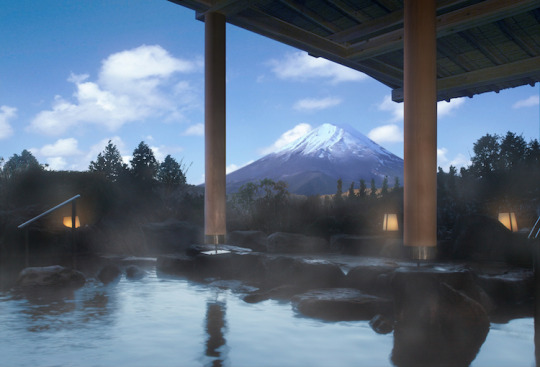#gallery-1 {
margin: auto;
}
#gallery-1 .gallery-item {
float: left;
margin-top: 10px;
text-align: center;
width: 100%;
}
#gallery-1 img {
border: 2px solid #cfcfcf;
}
#gallery-1 .gallery-caption {
margin-left: 0;
}
/* see gallery_shortcode() in wp-includes/media.php */
WELLNESS: Take a Soak in Japan’s Famous Hot Springs
Promising physical benefits,
relaxation and the opportunity to commune with nature, onsen bathing comes with a characteristic set of carefully observed
rules and is an experience so unequivocally Japanese, no trip is complete
without it. The Japanese have been bathing in natural hot springs since the 8th century, defining
any pool of water emerging at 25℃ or hotter and containing one or more
of select 19 mineral contents as an onsen, ripe for plunging
in.
Found both indoors and out, onsen
baths are taken at any time of day or night, but always after washing and
always naked. As a result, they’re not always a comfortable experience for more
prudish visitors, but nevertheless offer a great opportunity to get stuck into
Japan’s inscrutable culture.
There are more than two
thousand known onsen across Japan offering limitless opportunity to soak up the
local atmosphere by way of a relaxing dip. Here are our top three regions for
hunting down the nearest hot-spring…

1. Snow
bathing in Hokkaido
Chilly Hokkaido, in northern
Japan, spends much of the year buried beneath a blanket of snow. It’s
mountainous terrain also makes it a hotspot for onsen bathing, and offers the chance to kick-off your ski boots and soak in a steaming pool whilst gazing across
a picturesque snow-laden landscape.
Many of the mountain hotels
harbour high-quality onsens, and we recommend a stay in Asahidake Onsen. In a
small resort village on the side of Hokkaido’s volcanic Mount Asahi, in
Daisetsuzan (Big Snow Mountain) National Park, a multitude of hot springs
welcomes worn-out visitors off the mountain. Alternatively, Noboribetsu Onsen
is a must-see for many. Famous for its eleven types of spring, guests are
invited to pick their onsen to suit their personal needs, whilst five minutes
on foot from the town lies the breath-taking Jigoku-dani or ‘Hell Valley’ – a
450m wide volcanic crater expelling sulphuric gases, steam and scalding water.

2. Kicking-back
in Kyushu
Kyushu, the largest of Japan’s
southern islands, is home to the highest number of hot springs in the country,
meaning visitors are spoilt for choice. A trip to almost any district will put
you within a stone’s throw of a unique onsen experience, but for those
determined to see what is arguably Japan’s most famous hot spring town, don’t
leave Kyushu without a trip to Beppu. Home to the highest quantity of onsen
water in the country, several hundred springs make up eight onsen villages,
each with its own history and distinct spring water. Collectively, Beppu onsen
are the second largest hot springs in the world, and a view across the town
sees hot steam rising in plumes as guests enjoy the natural benefits of the
volcanic landscape.
Alternatively, for a more
low-key experience, head to picturesque Kurakawa Onsen. Wedged between Mount
Kuji and Mount Aso, 24 Japanese-style inn (ryokan) on either side of the peaceful Tanoharu River offer
the chance to onsen-hop on a special tegata wooden
pass.

3. Day-tripping
from Tokyo
For those pushed for time and
not able to stray far from the capital, there are a number of onsen within
shooting distance of Tokyo – ideal for day-trippers. Hakone, with its large
number of hot springs nestled in a forested valley along the shore of Lake Ashi (Ashi-no-ko) is one of Japan’s most popular onsen resorts due to its
close proximity to the city. An easy one and a half hours by train, Hakone
offers welcome respite from Tokyo’s busy streets.
Venture
a little further afield – two and a half hours by express train
then a half hour bus ride into the mountains – and you’ll get to soak in what
are considered some of Japan’s best hot spring waters. Having been recommended by
Dr. Von Baelz – a German doctor who served Japan’s Imperial Court in the 1880s
– the springs of Kusatsu, Gumma Prefecture, sit at an altitude of 1200 metres and
those escaping Tokyo for some mountain rest and relaxation can also enjoy a
picturesque hike in the fresh mountain air.

